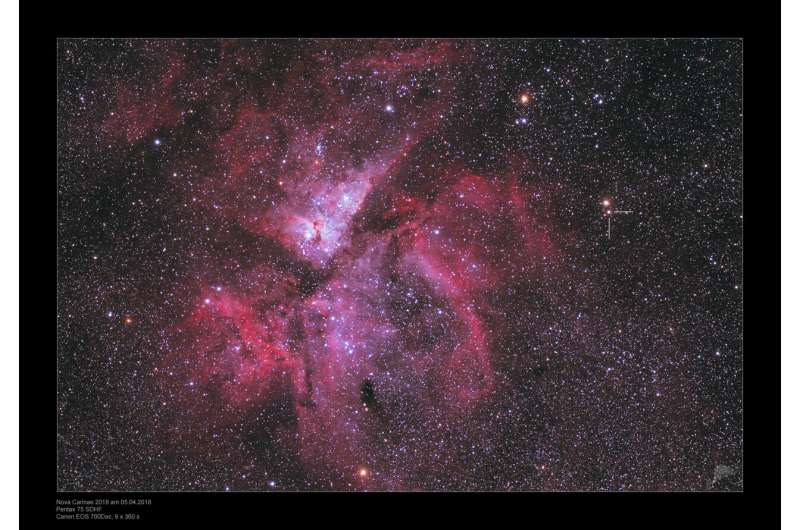Seeing the light: Study finds new way novae light up the sky

A nova, or stella nova, the Latin word for "new star," is an explosion on the surface of a star that can produce enough energy to increase the star's brightness by millions of times. Sometimes a nova, which occur in stars called white dwarfs, is so bright it appears as a new star to the naked eye.
The explosion occurs when a white dwarf star strips material from its companion star that piles up on the dwarf's surface, eventually triggering a thermonuclear explosion. While for many years astronomers have thought that nuclear burning of material on the surface of the white dwarf directly powered all the light from the explosion, more recently astronomers started debating that "shocks" from the explosion might power most of the brightness.
Now, an international team of astronomers from 40 institutes across 17 countries led by Michigan State University's Elias Aydi, has found that it is indeed shocks that cause most of the nova's brightness.
The research is detailed in a paper published in the journal Nature Astronomy titled, "Direct evidence for shock-powered optical emission in a nova."
"This is a new way of understanding the origin of the brightness of novae and other stellar explosions," said Aydi, a research associate in MSU's Department of Physics and Astronomy. "Our findings present the first direct observational evidence, from unprecedented space observations, that shocks play a major role in powering these events."
So, what are shocks and how do they form? Picture a supersonic jet airplane. When the jet exceeds the speed of sound, it produces a shock which leads to a loud sonic boom. In a nova explosion, the shocks produce light rather than sound.
When material blasts out from the white dwarf, said Aydi, it is ejected in multiple phases and at different speeds. These ejections collide with one another and create shocks, which heat the ejected material producing much of the light.
Another side effect of astronomical shocks are gamma-rays, the highest-energy kind of electromagnetic radiation. The astronomers detected bright gamma-rays from the star, known as nova V906 Carinae, whose explosion in the constellation Carina was first detected in March 2018.
Using NASA's Fermi Gamma-ray Space Telescope, they showed that V906 Car had the brightest gamma-rays ever observed for a nova, proving that it hosts energetic shocks.
But the real surprise came because an optical satellite—one of the six nanosatellites that make up a collection of satellites operated by an international consortium called the BRight Target Explorer Constellation of cube-sats—just happened to be looking at the part of the sky where the nova occurred. Comparing the gamma-ray and optical data, the astronomers noted that every time there was a fluctuation in gamma-rays, the light from the nova fluctuated as well.
"We observed simultaneous fluctuations in both the visual and gamma-ray brightness, meaning that both emissions are originating from shocks," said Kirill Sokolovsky, a research associate at MSU and a co-author on the paper. "This led us to the conclusion that shocks are indeed responsible for most of the brightness of the event."
"We were lucky that members of our team were observing that part of the sky with these special satellites and were able to collect this unprecedented set of data," Aydi said.
The team estimates that V906 Car is about 13,000 light years from Earth. This means that when the nova was first detected in 2018, it had actually happened 13,000 years ago.
This new information may also help explain how large amounts of light are generated in other stellar events, including supernovae and stellar mergers, in when two stars collide with one another.Other MSU researchers involved in the project are Laura Chomiuk, Jay Strader and Adam Kawash, all of the Department of Physics and Astronomy.
More information: Direct evidence for shock-powered optical emission in a nova, Nature Astronomy (2020). DOI: 10.1038/s41550-020-1070-y , nature.com/articles/s41550-020-1070-y
Journal information: Nature Astronomy
Provided by Michigan State University





















